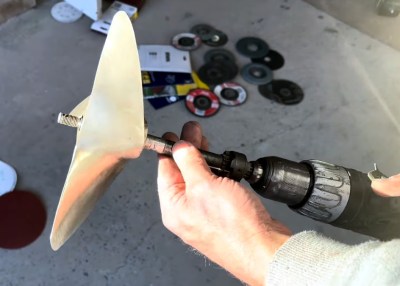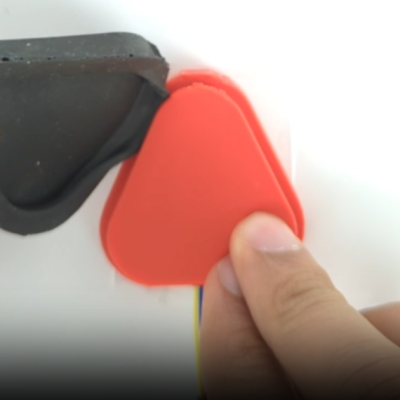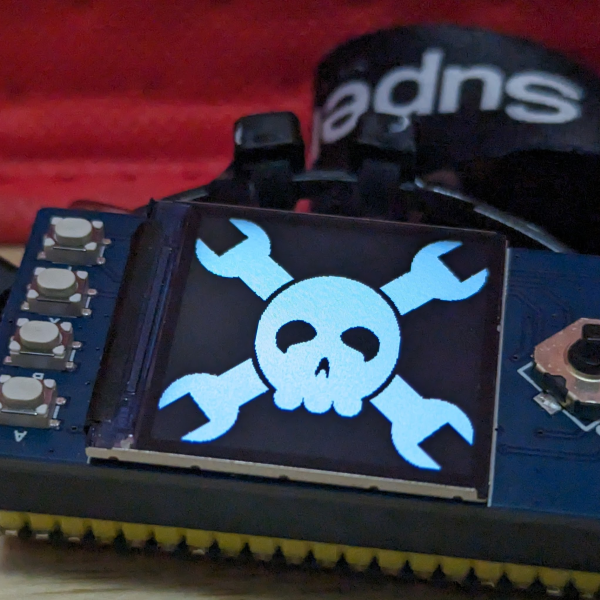Thanks a lot, Elon. Or maybe not, depending on how this report that China used Starlink signals to detect low-observable targets pans out. There aren’t a lot of details, and we couldn’t find anything approximating a primary source, but it seems like the idea is based on forward scatter, which is when waves striking an object are deflected only a little bit. The test setup for this experiment was a ground-based receiver listening to the downlink signal from a Starlink satellite while a DJI Phantom 4 Pro drone was flown into the signal path. The drone was chosen because nobody had a spare F-22 or F-35 lying around, and its radar cross-section is about that of one of these stealth fighters. They claim that this passive detection method was able to make out details about the drone, but as with most reporting these days, this needs to be taken with an ample pinch of salt. Still, it’s an interesting development that may change things up in the stealth superiority field.
Brass Propeller Gets Impressive Hand Trimming
Whether you’re a landlubber or an old salt, you’ve got to appreciate the effort that [The Aussie boat guy] puts into cutting an old brass propeller down into a far smaller and sleeker specimen. Especially since he does the entire thing with hand tools, a couple different calipers, and that most valuable of natural resources: experience.
The whole process was made somewhat easier by the fact that [The Aussie boat guy] had a model to work from — his friend had a small propeller that was already known to perform well, it was just a matter of cutting the larger prop down to match its dimensions. Using what appears to be pieces of leather (presumably for its flexibility), a template was made to accurately map out the front face of the blade.

By measuring out from the hub of the prop with his calipers, [The Aussie boat guy] was able to make sure the template was properly positioned before scribing its shape into the larger prop. An angle grinder was used to cut the shape out of each blade, followed by a smoothing off with a flap wheel.
But there was still a problem — the blades were the right shape, but they were far too thick. So he took the angle grinder to the back of each one to start removing material, using another set of calipers to occasionally spot-check them to make sure they were thinning out at roughly the same rate.
This thinning out process continued until the prop was brought into balance. How do you check that, you might be wondering? Well, if you’re a madman like [The Aussie boat guy], you chuck the thing into a power drill and spin er’ up to see how badly it shakes. But this only gives you a rough idea, so he has to move over to a somewhat more scientific apparatus that uses a set of parallel bars to help determine which blade is heavier than its peers.
Continue reading “Brass Propeller Gets Impressive Hand Trimming”
Robotic Touch Using A DIY Squishy Magnetic Pad
There are a number of ways to give a robotic actuator a sense of touch, but the AnySkin project aims to make it an overall more reliable and practical process. The idea is twofold: create modular grippy “skins” that can be slipped onto actuators, and separate the sensing electronics from the skins themselves. The whole system ends up being quite small, as shown here.

The skins are cast in whatever shape is called for by using silicone (using an off-the-shelf formulation from Smooth-on) mixed with iron particles. This skin is then slipped onto a base that contains the electronics, but first it is magnetized with a pulse magnetizer. It’s the magnetic field that is at the heart of how the system works.
The base contains five MLX90393 triple-axis magnetometers, each capable of sensing tiny changes in magnetic fields. When the magnetized skin over the base is deformed — no matter how slightly — its magnetic field changes in distinct ways that paint an impressively detailed picture of exactly what is happening at the sensor. As a bonus, slippage of the skin against the sensor (a kind of shearing) can also be distinctly detected with a high degree of accuracy.
The result is a durable and swappable robotic skin that can be cast in whatever shape is needed, itself contains no electronics, and can even be changed without needing to re-calibrate everything. Cameras can also sense touch with a high degree of accuracy, but camera-based sensors put constraints on the size and shape of the end result.
AnySkin builds on another project called ReSkin and in fact uses the same sensor PCB (design files and bill of materials available here) but provides a streamlined process to create swappable skins, and has pre-made models for a variety of different robot arms.
Hackfest, A New Event For Your European Calendar
Our community’s events are something special, bringing as they do an opportunity to meet and mingle with other hackers whether their field be hardware, software, or security, to share ideas, and to see some very cool projects. Here at Hackaday aside from our own Supercon and Hackaday Europe events we try to take in as many as we can over the year, and thus it’s always interesting to sot a new one. If you’re in north-west Europe next weekend, consider dropping by Hackfest, in the Dutch city of Enschede, right on the German border.
Looking at the program and the projects and workshops listed on the website we can see robotics, lockpicking, demoscene, retrocomputing, and plenty of open source. There are quite a few names which have featured at times here on these pages, something which certainly piqued our interest. Finding that it’s only 15 Euros for a weekend’s admission sealed the deal, and thus it’s time for Hackaday to break out the trusty Interrail pass once more and make the trek. Sadly many of Hackaday’s community will be too far away to join us, but if you’re close enough to make it then it’s one to consider.
This is a part of the world it’s fair to say isn’t often featured on Hackaday, but some of you might remember the city as being at the centre of a Wi-Fi tracking scandal.
Where Did The Japanese Computers Go?
If you are a retrocomputer person, at least in North America and Europe, you probably only have a hazy idea of what computers were in the Japanese market at the time we were all buying MSDOS-based computers. You may have heard of PC-98, but there were many Japanese-only computers out there, and a recent post by [Misty De Meo] asks the question: What happened to the Japanese computers?
To answer that question, you need a history lesson on PC-98 (NEC), FM Towns (Fujitsu), and the X68000 (Sharp). The PC-98 was originally a text-only MSDOS-based computer. But eventually, Microsoft and NEC ported Windows to the machine.
The FM Towns had its own GUI operating system. However, it too had a Windows port and the machine became just another Windows platform. The X68000, as you may well have guessed, used a 68000 CPU. Arguably, this was a great choice at the time. However, history shows that it didn’t work out, and when Sharp began making x86-based Windows machines — and, of course, they did — there was no migration path.
[Misty] makes an interesting point. While we often think of software like Microsoft Office as driving Windows adoption, that wasn’t the case in Japan. It turns out that multitasking was the key feature since Office, at the time, wasn’t very friendly to the native language.
So where did the Japanese computers go? The answer for two of them is: nowhere. They just morphed into commodity Windows computers. The 68000 was the exception — it just withered away.
Japanese pocket computers were common at one time and have an interesting backstory. Japanese can be a challenge for input but, of course, hackers are up to the challenge.
FreeCAD Is Near 1.0
The open-source parametric 3D modelling software, FreeCAD, is out in a release candidate for version 1.0. If you’ve tried FreeCAD before and found a few showstoppers, it might be a good time for you to test it out again because the two biggest of them have been solved in this latest version.
First, version 1.0 finally implements a solution to the “topological naming problem”. Imagine you want to put a hole into a surface. The program needs to know on which surface to put the hole, and so it refers to this surface by name / number. Now imagine you subdivide the surface, and both subsections get new names. Where does your hole go now? If you want to dig into the issue, the inimitable [MangoJelly] has a great video about the topo naming problem. Practically, there were workarounds, like only adding chamfers after the main design has stabilized, but frankly it was a hassle to remember all of the tricks. This is a huge fix.
The second big fix concerns assemblies. Older versions of FreeCAD were great for making single parts, but combining them all together inside the CAD program was always janky. Version 1.0 combines the previous two patchwork assembly workbenches into one, and it’s altogether more pleasant to use. The constraints of how two parts move when held together with an axle just works now, and this is a big deal for multi-part models.
If you’re coming from any other parametric CAD program, most of FreeCAD will seem familiar to you, but there will also be workflow differences that will take some getting used to. In trade, what do you get? Scriptability in Python, real open source software, and all of the bells and whistles for free. Now that its two biggest pain points have been addressed, FreeCAD has become a lot easier to love. We’re looking forward to some good V1.0 tutorials in the future, and we’ll keep you posted when we find them.
The Surprising Effects Of Fast Food Kiosks
For as long as there have been machines, there have been fears of machines taking your job. One of the latest incarnations of this phenomenon is the fast-food ordering kiosk. No longer will you have some teenager asking you if you want fries with that. These days, you are more likely going to find the question on a touch screen. So, are those poor kids out of an entry-level job? Apparently not, according to a recent CNN story.
According to McDonald’s, a business that embraces the kiosks, the new technology increases sales and creates more jobs, albeit more jobs further behind the counter. Part of the reason is that while “Do you want fries with that” is a cliche, it is also a sound business practice. Cashiers should try to upsell but don’t always do so. The kiosk always remembers to offer you an apple pie or whatever else they want to move today.
Continue reading “The Surprising Effects Of Fast Food Kiosks”

















